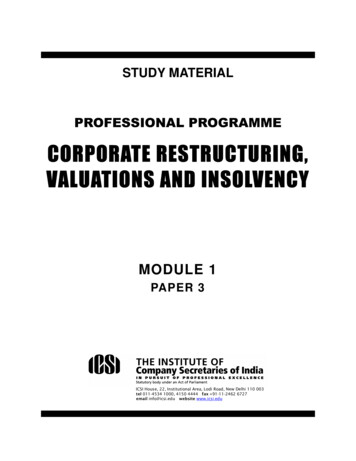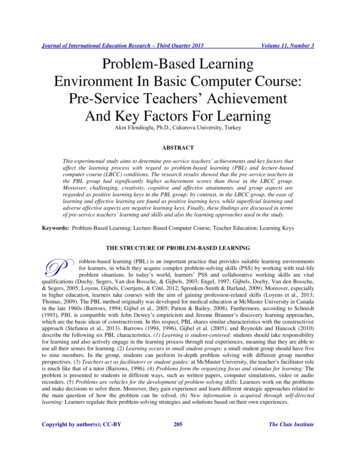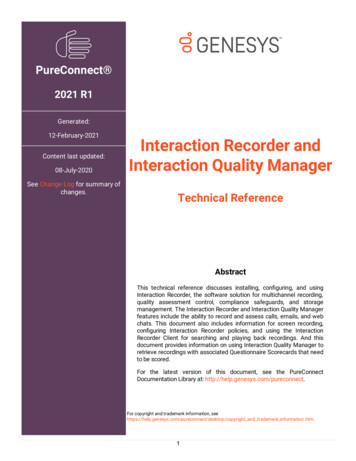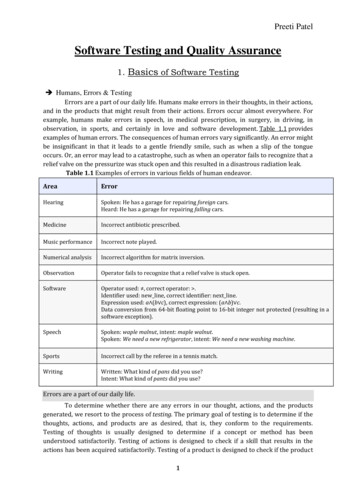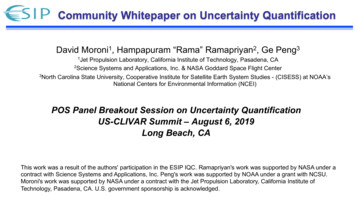
Transcription
Report 2008:11 RE-learning qualityAspects and criteria for evaluationof e-learning in higher education
Swedish National Agency for Higher Education Luntmakargatan 13 Box 7851, 10399 Stockholm tel. 46 8 563 085 00 fax 46 8 563 085 50 e-mail hsv@hsv.se www.hsv.seE-learning qualityAspects and criteria for evaluation of e-learning in higher educationPublished by the Swedish National Agency for Higher Education 2008Högskoleverkets rapportserie 2008:11 RContents: National Agency’s Department of Evaluation, Eva ÅströmGraphic design: National Agency Information departmentPrinted by: Åtta.45 Tryckeri AB, Solna, May 2008Printed on environmentally certified paper
n11Quality assurance and e-learning in SwedenAims, framework and methods1114The European view on e-learning and the assessmentof quality17The European Union’s eLearning programmeLifelong learning programme 2007–2013Selected European organisations and networks182121Quality assessment of e-learning in selected countries27NorwayFinlandDenmarkThe NetherlandsUnited g quality – ELQ39ELQ – a model for quality assessment of e-learningQuality aspects and criteria3940Policy issues for quality assurance agencies57Integration of e-learning criteria in the national quality assurance systemIntelligence and competence within the organisationCross-boundary education changes the conditions for quality assuranceMethodological development57585959References61Appendix 167Appendix 271Appendix 379Appendix 491
PrefaceThe Swedish National Agency of Higher Education (HSV) has initiateda project to define quality in distance learning/e-learning. Work on theproject began in 2006, with an evaluation of distance-based teacher training programmes. In the same year an analysis of the current methods ofevaluation used by the Swedish National Agency and the Danish Evaluation Institute was presented at the ICDE world conference in Rio de Janeiro, Brazil. The analysis aimed to identify the important variables forgood quality in technology-based flexible education. In 2007, work began on an international knowledge survey, the resultsof which are included here. The report analyses how quality in e-learning isperceived within the EU, in a number of individual European countries, inthe U.S. and Australia, and in international research. Based on this analysis, a model for e-learning quality – ELQ – has been developed.The knowledge survey is intended to serve as a basis for the further development of the National Agency’s evaluations of the quality of highereducation, so that they may better capture the quality of distance learningprogrammes and other education programmes that are carried out usingmodern information and communication technology. Another aim of thesurvey is to contribute to international development efforts within the elearning sector.The knowledge survey was compiled by National Agency’s Departmentof Evaluation. Eva Åström, project manager at the National Agency, managed the project. For data collection and analysis, two external expertswere engaged: Henrik Hansson, PhD, Stockholm University, and PerWestman, PhD, NSHU . Magnus Johansson, project manager at the National Agency, also participated.The work of the National Agency on quality in e-learning will continue in 2008. There are plans for a project aimed at developing methodsfor evaluating higher education based on information and communication technology. . Rapport 2007:41 R, Vad är kvalitet i distansutbildning? Utvärdering av lärarutbildning på distans. . The title of the paper is National Evaluations of Quality in Flexible Education– the Cases of Sweden and Denmark. . Swedish Agency for Networks and Cooperation in Higher Education.
SammanfattningRapporten E-learning quality. Aspects and criteria for evaluation of e-learning in higher education ingår som en del i Högskoleverkets pågående satsning på att öka kunskapen om vad som utgör kvalitet i e-lärande, och hurdenna kvalitet kan utvärderas inom ramen för ett nationellt kvalitetssäkringssystem.I rapporten presenteras en modell för utvärdering av kvalitet i e-lärandet. Denna har utvecklats bland annat med stöd av analyser av policydokument, nätverkssamarbeten och utvecklingsprojekt som initierats inom ramen för det Europeiska samarbetet. En annan del av rapporten innehållerkortfattade beskrivningar och analyser av hur man inom nationella utvärderingsorganisationer och organisationer med särskilt uppdrag att främjanationell utveckling av e-lärande, hanterar frågan om kvalitetsutvärderingav e-lärande och distansutbildning. Denna del omfattar nio länder.Analyserna visar att även om e-lärande uppmärksammas i många europeiska sammanhang och enskilda länder, så är det först under senare tid,och betydligt mer sporadiskt, som frågan väckts om hur kvaliteten i dettae-lärande ska bedömas. Kvalitet i e-lärande framstår på många håll somen icke-fråga.Ett centralt underlag för den utvärderingsmodell som presenteras ärden genomgång av aktuell forskning inom området som också ingår irapporten.Högskoleverkets modell för utvärdering av kvaliteten i e-lärande – Elearning quality (ELQ ) – innehåller tio kvalitetsaspekter som enligt vårmening är centrala vid bedömning av kvaliteten i e-lärande: material/innehåll struktur/virtuell miljö kommunikation, samarbete och interaktivitet bedömningar av studenternas prestationer flexibilitet och anpassning support (till studenter och anställda) anställdas kompetens och erfarenhet ledarskap och visioner resursallokering process- och helhetssyn
Vi menar att kvaliteten i e-lärande måste bedömas ur ett systemperspektiv,dvs. att kvaliteten i utbildningen bestäms av samtliga ovanstående aspektersammanvägda, samt relationen mellan dessa.En annan central slutsats är, att om en nationell myndighet eller annanorganisation ska utvärdera e-lärande räcker det inte med att utveckla kvalitetsaspekter. Den utvärderande organisationen behöver även utveckla ochanpassa de egna arbetssätten samt säkra den interna kompetensen: De metoder som normalt används vid kvalitetsutvärdering behöver anpassas för att vara tillämpbara vid utvärdering av olika former ave-lärande. Kvalitetsaspekter för e-lärande behöver integreras i befintliga kvalitetssäkringssystem. Intern kompetensförsörjning och informationsförsörjning inome-lärandeområdet behöver säkras. Interna arbetssätt behöver anpassas efter de särskilda villkor somutvärdering av gränsöverskridande utbildning innebär.
SummaryThe report E-learning quality. Aspects and criteria for evaluation of e-learning in higher education is part of an ongoing endeavour by the SwedishNational Agency of Higher Education to develop knowledge about whatconstitutes quality in e-learning, and how such quality may be assessedwithin the framework of a national quality assurance system.The report presents a model for quality assessment of e-learning. Thismodel has been developed using analyses of policy documents, networksand development projects initiated within the framework of Europeancooperation. Another section of the report contains brief descriptions andanalyses of how different national assessment organisations and agenciescharged with promoting the national development of e-learning deal withthe question of quality assessment of e-learning and distance learning.These descriptions and analyses cover nine countries.The analyses indicate that while e-learning is on the agenda in many European contexts and in individual countries, it is only recently – and muchmore sporadically – that the subject has been broached of how e-learningquality should be assessed. In many organisations, quality in e-learningappears to be a non-issue.A survey of current research in the area is also included in the report,and serves as the central basis for the proposed assessment model.The National Agency’s model for assessing quality in e-learning – Elearning quality (ELQ ) – comprises ten quality aspects which, in our view,are central to such assessments: Material/content Structure/virtual environment Communication, cooperation and interactivity Student assessment Flexibility and adaptability Support (student and staff) Staff qualifications and experience Vision and institutional leadership Resource allocation The holistic and process aspect
Further, it is our view that e-learning quality must be assessed from a systems perspective, i.e. that the quality of the education is determined by allof the above aspects taken together, and by their interrelationships.Another central conclusion is that if a national agency or other organisation is to assess e-learning, it is not enough simply to draw up qualityaspects. The assessing body also needs to develop and adapt its own working methods and guarantee its internal competence: Existing methods of quality assessment need to be adapted. Quality aspects for e-learning need to be integrated into existingquality assurance systems. Internal competence and the provision of information in the e-learning area need to be guaranteed. Internal working methods need to be adapted to the special conditions which apply for the assessment of borderless education.10
IntroductionQuality assurance and e-learning in SwedenQuality assurance of Swedish higher educationIn Sweden, academic programmes are offered by 61 universities, university colleges and independent programme providers. The main tasks of theuniversities and university colleges are to provide undergraduate and postgraduate programmes and to interact with the surrounding community.A major proportion of state-funded research takes place at the universitiesand university colleges.The Swedish National Agency for Higher Education is a central authority that deals with issues concerning Swedish universities and universitycolleges. The Agency’s tasks include carrying out quality reviews, supervising, monitoring and developing higher education, producing reports andanalyses, evaluating foreign qualifications, and providing information tostudents. Higher education institutions are responsible for the quality development of their programmes and for quality assurance.A national quality assurance system was developed in 2001, when theNational Agency was commissioned by the Swedish Government to evaluate all academic subjects and vocational programmes at all higher education institutions over a six-year period.A new quality assurance system was launched in 2007. The new systemis made up of five different components. These are: audits of the quality assurance mechanisms of the higher educationinstitutions evaluations of subjects and programmes appraisals of the entitlement to award degrees thematic evaluations and thematic studies identification of centres of educational excellenceDistance education/e-learning in SwedenIn Sweden the same universities and university colleges that organise campus-based education also offer e-learning courses and programmes. Thissystem is commonly called dual mode.The policy in Sweden is that the same fundamental quality requirementsshould apply to e-learning as to campus-based higher education. How11
ever, there is also consensus that there are significant differences betweene-learning and campus-based education. To address these differences, adjustments in the methods of evaluating higher education are required. Traditional quality criteria and evaluation methods do not identify and assessnew aspects of higher education that are introduced by e-learning.Swedish National Agency for Higher Education– Evaluation of distance-based teacher training programmesIn order to develop quality aspects and criteria that are adapted to distanceeducation and e-learning, the Swedish National Agency for Higher Education initiated an evaluation of distance-based teacher training programmesin 2006 (National Agency 2007).Five quality aspects of particular interest in distance/flexible/e-learningwere identified: Information and communication technology Planning and structure Teacher skills Adjustment to student needs Infrastructure and organisation . Criteria: carefully planned ICT profile; the aims, content and method for education should govern the choice of ICT tools; well-functioning ICT hardwareand software; well-functioning technical support, offered both to students andto teachers/tutors; carefully planned introduction to the ICT tools, offered bothto students and to teachers/tutors. . Criteria: distinctive programme/course structure, including specified studypaths; carefully planned tutoring system; syllabi including both traditional literature and new digital learning resources. . Criteria: access to in-service training; technical-pedagogical and distance teaching; adjustment of teachers’ working conditions. . Criteria: aims of education that correspond to the needs of (distance) students;planning and implementation of education that is consistent with students’needs, for instance regarding choice of hardware and software, and the amountof physical/digital meetings. . Criteria : student access to technical support, library and study guidance; internal and external professional cooperation and exchange in the planning andimplementation of the programme/course; quality-assurance system which alsocovers teaching at external sites such as local study centres.12
Swedish Net University Agency/NSHU – Quality criteria for ITsupported distance educationThe Swedish Net University Agency was formed in 2002 with the aim ofincreasing access to and widening participation in higher education. Inthis context one of its tasks was to enhance distance education. A report on the quality of IT-supported distance education (Nätuniversitet, 2003) was compiled under the auspices of the agency in 2002–2003.The report focused on quality audits and defined four main quality processes:1) Accessibility2) Widening participation3) Transfer of credits4) Educational developmentThe quality processes were further divided into:a) Prerequisites10 Accessibility Widening participation Range of courses and transfer of credits Competence for IT-supported learning Student representation Technical support Library functions Study guidanceb) Implementation11 Educational/didactic model Forms of assessmentc) Results and evaluation . The Agency was closed down in 2006 and its tasks were taken over by theSwedish Agency for Networks and Cooperation in Higher Education (NSHU).10. Prerequisite: The report points out that both staff and students need technicaladvice and support during the entire process, but that this is especially important before the programme starts. Flexibility and accessibility were primarypoints of focus. The needs of students with disabilities should be met. Continuous in-service training of all staff categories and cooperative teamwork in planning and constructing courses are other major changes compared to traditionalon-campus education.11. Implementation: The criteria for implementation bear a striking similarity toon-campus criteria. It is worth noting that greater emphasis is placed on theimportance of the organisation of instruction and the learning environment.Another major issue is the planning of activities for the periods when studentsand teachers do not meet e.g. asynchronous communication interactivity withdigital material etc.13
Aims, framework and methodsQuestions to be answeredThe main aim of this review is to provide a synthesis based on Swedishand international research and practice in quality and quality assessmentof e-learning. It is meant to be used as a basis for strategic developmentof the Swedish National Agency for Higher Education’s quality-assurancesystem. In the report we identify problematic areas and give some recommendations for quality aspects and criteria to complement the Agency’sexisting criteria.To this end, the following questions are put forward: What constitutes quality in e-learning in higher education accordingto:- Swedish policy?- EU policies, EU development projects and European networks andorganisations?- National agencies and organisations in Sweden, Norway, Finland,Denmark, the UK, the Netherlands, Australia, Canada and the U.S.?- Recent research in the field of e-learning?Methods and sources of informationThe report is based on the following material and procedures related tothe four questions above:1. The Swedish context and current situation Summary and analysis of policy documents from the Swedish National Agency for Higher Education and the Swedish Net UniversityAgency/NSHU concerning e-learning in higher education (in the introductory chapter).2. The European Union context and current situation Summary and analysis of relevant policy documents concerning elearning in higher education within the European Union. Analysis of selected e-learning projects and organisations at the EUlevel.3. Approaches adopted by national agencies in other countries An e-mail questionnaire to national agencies and organisations forhigher education/e-learning in higher education in Australia, Canada,14
Denmark, Finland, the Netherlands, Norway and the United Kingdom requesting relevant reports, books, documents, URLs, and contact persons for further interviews.12 Summary and analysis of relevant information and documents obtained from the national agencies and organisations above, and fromthe Council for Higher Education Accreditation (CHEA) and theDistance Education and Training Council (DECT) in the UnitedStates.4. Issues and quality aspects of e-learning in higher education discussed incurrent research Analysis of e-learning articles published between 2002 and 2007 inonline databases for e-journals available at the Mid Sweden University, using the following descriptors: “Quality assessment higher education”, “Quality evaluation higher education” and “Quality audithigher education” combined with one or several of the following keywords: “e-learning”, “online” and “distance”. Analysis of selected literature cited in the articles accumulated in theoriginal searches above. Inductive study of the most recently published articles in two e-learning journals: the European Journal of Open and Distance Learning(EURODL) and the International Review of Research in Open andDistance Learning (IRRODL).Definitions and scopeIn this report we have chosen the term e-learning (120 million hits13) tosignify all forms of technology-supported learning, such as distance learn12. The organisations and agencies are: The Swedish Agency for Flexible Learning;The Swedish Agency for Networks and Cooperation in Higher Education; TheNorwegian Agency for Quality Assurance in Education; Norway Opening Universities; The Norwegian Networked University; The Finnish Higher EducationEvaluation Council; The Finnish Virtual University; The Danish EvaluationInstitute; The Danish Association of Flexible Learning; Centre for HigherEducation Research and Information (UK); The Quality Assurance Agency forHigher Education (UK); The Open University (UK); The Centre for Researchand Evaluation (UK); Quality Assurance Netherlands Universities; Nederlands-Vlaamse Accreditatieorganisatie; The European Association for DistanceLearning; The Australian Universities Quality Agency; The Open and DistanceLearning and Association of Australia; The Higher Education Quality Council of Ontario; The Commission d’évaluation de l’enseignement collégial duQuébec; The Canadian Network for Innovation in Education.13. Number of hits on Google, 21 December 2007.15
ing, online learning, online education, distance education, technology-enhanced education, flexible learning, flexible education and IT-supportededucation. The concept of e-learning is relevant both in distance education and campus-based learning: “E-learning is naturally suited to distancelearning and flexible learning, but can also be used in conjunction withface-to-face teaching, in which case the term blended learning is commonly used.”14A recurrent theme in the discussion about e-learning is whether it offershigher or lower quality than other higher education. The quality of e-learning has often been viewed with scepticism and been the target of criticism(e.g. Zhao, 2003; Yeung, 2002; Rovai, 2003). This criticism has focused onthe lack of (physical) interaction (Yeung 2002 and ref. therein), technicalproblems (Zhao 2003), or a technological and aesthetic focus instead ofan educational one (Barbera 2004).15 Other research reports show that thecourse delivery medium is rarely the determining factor for quality (Rovai 2003), or that online education in itself can be a quality enhancementfactor in terms of accessibility, collaboration or community-building, foreither teachers or learners (e.g. Connolly et al. 2005, Jara 2006).The issue of whether e-learning offers higher, equal or lower quality incomparison to other types of education has not been dealt with in this report. Instead, the report focuses on the more open question of what quality in e-learning actually comprises. How can quality be defined in thiscontext in order to be assessed?14. Wikipedia, 22 February 2008.15. In “Teaching courses online: a review of the research” (Tallent-Runnels et al.2006), the authors show that the learning outcomes appear to be the same as intraditional courses. David Noble (1998), on the other hand, argues that highereducation institutions are going too far in the hunt for cost reductions, leadingto the automation of higher education and its transformation into diploma millswith a global reach. Nicholas Burbules (2000) discusses old and new problemsin education which have been reinforced by ICT. He brings up issues such asthe quality of information, credibility and misleading information.16
The European view on e-learningand the assessment of qualityDecisions made within the framework of European cooperation on e-learning, implemented policies and national development projects all affect theconditions for the work undertaken in individual Member States.This chapter describes a number of policies, projects, organisations andnetworks which we perceive as being in some way key to, or representativeof, the views on quality and quality assurance in e-learning that feature inEuropean cooperation.The European Commission’s eLearning Action PlanIn May 2000, the eLearning: designing tomorrow’s education initiative wasadopted by the European Commission. This initiative was part of thecomprehensive eEurope Action Plan16 that aimed to overcome the barriersholding back the utilisation of digital resources in Europe.In 2001, the eLearning Action Plan was formulated to present ways ofimplementing the eLearning initiative. The action plan covers the period2001-2004. It explains how e-learning fits into the context of eEurope, i.e.how the use of new multimedia technologies and the Internet can improvethe quality of learning by facilitating access to resources and services aswell as exchanges and collaboration. E-learning is defined as an essentialprecondition for lifelong learning and therefore also as a driving force underlying cohesive and inclusive societies and competitive economies.The initiative places emphasis on creating appropriate conditions forthe development of content, services and learning environments which aresufficiently advanced and relevant to education. The availability of standards is described as particularly important. The importance of establishedconditions conducive to change and to adaptation of the ways in whicheducation and training systems are organised is also emphasised.Four lines of action have been identified, i.e. areas of particular importance for the successful implementation of e-learning in Europe:16. http://ec.europa.eu/information society/eeurope/2002/action plan/pdf/actionplan en.pdf.17
Infrastructure and equipmenttrainingservices and contentcooperation and dialogueThe European Union’s eLearning programmeAbout the programmeThrough the eLearning Initiative and Action Plan, the European Commission has gained experience in encouraging cooperation, networkingand the exchange of good practice on a European level. The eLearningprogramme17 is described as a further step towards realising the vision ofenabling technology to serve lifelong learning. The aim of the eLearningprogramme is the effective integration of information and communicationtechnologies (ICT) in education and training systems in Europe (2004– 2006).The programme focuses on a set of actions in high priority areas, whichwere chosen for their strategic relevance to the modernisation of Europe’seducation and training systems. These four lines of action are: Promoting digital literacy European virtual campuses e-Twinning of schools in Europe and the promotion of teacher training Transversal actions for the promotion of e-learning in EuropeHorizontal E-learning Integrated Observation System(HELIOS)The Horizontal E-learning Integrated Observation System (HELIOS)18project is supported by the European Commission within the frameworkof the eLearning Programme. It is a research project intended to establisha sustainable observation platform for monitoring the progress of e-learning in Europe vis-à-vis policy objectives, and to forecast future scenariosof e-learning evolution.HELIOS aims to show not only the state of development of e-learning,but also the impact of e-learning on the following policy priorities:17. . ojects/.18
Access to learningEmployabilityPersonal development/citizenshipInternationalisation of education and trainingOrganisational changeInnovation of education and trainingSix thematic reports have been produced for each of the policy areasabove.19E-xcellenceE-xcellence20 is a two-year project, which was undertaken under the auspices of EADTU21 and co-funded by the European Commission eLearning programme. E-xcellence aims to supplement existing systems of quality assurance on e-learning specific issues, by focusing on parameters ofquality assurance that govern e-learning. A quick scan tool for self-assessment has been developed that contains thirty-three benchmarks. Thebenchmarks are divided into six areas: strategic management; curriculumdesign; course design; course delivery; staff support; student support (Appendix 1). The project involves a pool of experts from twelve Europeaninstitutions.There will be an extension of the E-xcellence project aimed at implementing the quick scan tool in thirteen countries between 2008 and 2010.It will also involve making three complete evaluations of higher education programmes and extending the network of experts for assessment ofe-learning courses and programmes.Sustainable environment for the evaluation of quality ine-learning (SEEQUEL)The Sustainable Environment for the Evaluation of Quality in E-Learning(SEEQUEL) project22 originates from the joint initiative of the e-LearningIndustry Group (eLIG) and of a number of European expert organizationsand associations at all levels of education and n Association of Distance Teaching Universities, el/index.The SEEQUEL project is co-funded by the European Commission, DG education and Culture under the eLearning initiative.19
The project objectives are to address the need for a common strategyto define and implement international quality standards. A core qualityframework for e-learning in all educational contexts has been developed.SEEQUEL does not aim for a normative definition of quality. The criteriacan be weighted depending on the user profile. The framework comprisesthree areas (see also Appendix 1): Learning sources Core learning processes Learning contextThe Triangle ProjectThe Triangle project24 is funded by the European Commission. Its mainobjectives are: to promote European diversity in quality approaches and services inthe field of learning, education and training to connect results and concepts for European e-learning quality asdeveloped in three e-learning quality projects: SEEL,25 EQO26 andSEEQUEL to broaden the discussion and discourse on e-learning quality to provide a sustainable infrastructure as a single entry point for elearning quality.European University Quality in eLearning (UNIQUe)The UNIQUe project27 aims to enhance the reform process of Europeanhigher education institutions by creating an eLearning quality label forICT-use in higher education. The report eLearning quality in EuropeanUniversities was produced in 2007. It concluded that “within Europe abroadly acceptable Quality Accreditation system in e-learning within HE24 hat is efquel /whatis triangle .htm.25. The SEEL project focuses on the impact of e-learning quality policies on localand regional development. Among the activities includ
99 Stockholm tel. 46 8 563 085 00 fax 46 8 563 085 50 e-mail hsv@hsv.se www.hsv.se E-learning quality . dvs. att kvaliteten i utbildningen bestäms av samtliga ovanstående aspekter sammanvägda, samt relationen mellan dessa. En annan central slutsats är, att om en nationell myndighet eller annan .

